- THE SPALDING RESEARCH PROJECT -

See also: Jerome J. Knuijt's "The Anthon Affair" | Richard Stout's Review of Moore's article
|
THE 1823 DETROIT MANUSCRIPT:
The 1823 Detroit Manuscript Although "media events" are usually associated with the modern era, human interest has always been captured by sensational news stories. One such event occurred in 1823, when a person indirectly associated with the family of Joseph Smith sent noted New York City linguist Dr. Samuel Mitchill a sample of strange writing taken from an apparently ancient book which had been recently dug out of the earth. It was in March of that year when Col. Abraham Edwards, a prominent Detroit entrepreneur, discovered a deteriorating parchment manuscript written in curious hieroglyphics 1 hidden up within the foundation of an old Detroit house. 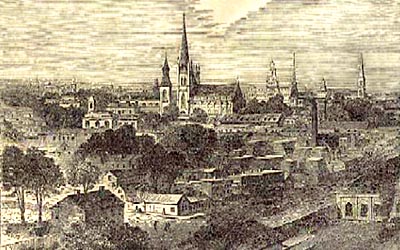
Early View of Detroit, Michigan Almost immediately this discovery became the subject of considerable discussion, resulting in the manuscript being placed on public display at the local newspaper office, whereupon the editor provided his readers with reports of the intriguing discovery. Since none of the locals was able to read or even to identify the strange text, examples of a few pages of the text were eventually sent to various philologists experts for examination, one of whom was the renowned Dr. Samuel L. Mitchill of New York City. As the weeks passed and the mystery deepened, details of the affair were covered and copied at length by various newspapers from Michigan eastward throughout Ohio, Pennsylvania, New York, New England and even Canada. Eventually some knowledgeable investigators recognized that the manuscript was a Roman Catholic religious text which had apparently originated in Ireland and was partly written in an obscure form of early shorthand script, dating back to the 16th century. 
Dr. Samuel L. Mitchill The Strange Story Continues Ultimately it was decided that the old text had probably been brought to the Detroit area by Catholic monks sent to evangelize the local Indians, during the early 18th century. As one would expect, most of the curiosity surrounding this strange document stemmed from the many odd, hieroglyphic-like symbols appearing in the manuscript's peculiar form of writing. Indeed, these symbols were so unusual that some of the first investigators to examine the manuscript thought its text might have been written in some arcane form of ancient Saxon, or Phoenician, or even Sumarian. In short, many noted observers were completely baffled by the strange symbols, and because of this, what under normal circumstances, might have been a relatively minor news story, attracted a great deal of national attention, as the original news reports from Detroit were copied by editor after editor, and generally reprinted with commendable attention to accuracy and detail. Even so, no matter how fascinating this story may have been during its brief tenure, it would ultimately have rated little more than a cobweb in the dustbin of history -- except for a few important items, which after all, suggest it may be considerably more significant. Foremost among these items, is a little known detail of history: that Col. Abraham Edwards, the man who initially unearthed the strange manuscript, was an occasional business partner of a certain Detroit resident named Stephen Mack. This same Stephen Mack was both a maternal uncle to Joseph Smith, Jr., and a cousin to the Book of Mormon's leading "witness," Oliver Cowdery. The Cowdery Connection Although Messrs. Edwards and Mack reportedly once operated a boat building or ship outfitting business, along the Connecticut River, their first documented cooperation was in the Detroit-Pontiac area of Michigan after the War of 1812. Mr. Mack moved from Tunbridge, Vermont to the then far-flung outpost of Detroit in 1810, looking for lucrative business opportunities. During the War of 1812, Stephen Mack (newspaper accounts call him "Major Mack") served in the American army in that region of the country, but he did not relocate his family there until 1822. When Major Stephen Mack finally moved his wife and children west, his party, naturally taking the Genesee Road west, would have passed through Palmyra on their way to Buffalo (from whence they could take lake passage to Detroit). By an odd coincidence, Stephen Mack's cousin, Oliver Cowdery, first left Vermont at almost exactly this same time. According to one of Oliver Cowdery's old schoolmates, Hiland Paul, the young Oliver "attended school in the [Wells] District" of Vermont "in 1821 and 1822." Oliver "then went to Palmyra." Probably this means that young Cowdery finished his schooling in his home town of Wells, during the winter term (lasting from after the fall harvest in 1821, until the spring planting season of 1822) and then joined the annual emigration of New Englanders to western New York. 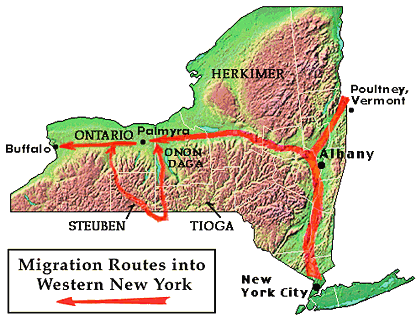
While there is no proof for this conclusion, Oliver Cowdery could easily have traveled as a member of the Mack family migration. On his way westward, Stephen Mack would have certainly have stopped to visit his sister, Lucy Mack Smith, and her family. This would have been an excellent opportunity for one of Lucy's boys (say, Joseph Smith, Jr., then 17 years old) to have accompanied the Mack emigrants westward, at least as far as Buffalo. From Buffalo, at the western extremity of Lake Erie, it was only a short journey to the Western Reserve country of Ohio, where the family of Oliver's elder brother, Erastus Cowdery, along with other Cowdery cousins, were then living. In this context, it is appropriate to recall that one of Erastus Cowdery's near neighbors in Trumbull County, Ohio, between 1819-1822, was none other than the Rev. Sidney Rigdon. The January, 1822 departure of Sidney Rigdon to accept a ministerial appointment in nearby Pittsburgh presented no major difficulty to his continuing to frequent his old haunts near Erastus Cowdery's home. Not only did Sidney Rigdon's in-laws live in that area, but in May of 1822, Rigdon is known to have preached a funeral sermon at Auburn, just two dozen miles northwest of Erastus Cowdery's home, and the main stage line road north passed within walking easy distance of Erastus' farm. Whatever the exact circumstances may have been during that distant era, the opportunities were certainly there for Oliver Cowdery, Sidney Rigdon, and Joseph Smith to have met and interacted together, either in western New York 2 northern Pennsylvania 3 or eastern Ohio. 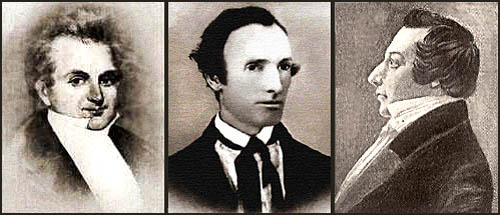
Three of the Earliest Mormons: Rev. Sidney Rigdon, Oliver Cowdery and Joseph Smith, Jr. Needless to say however, the official version of Latter Day Saint history does not admit to any possibility that these three men could have known each other at such an early date, or that their meeting together could have led to a clandestine cooperation from which Book of Mormon emerged as a leather bound volume in 1830. The standard Mormon claim has always been, and continues to be, that Oliver Cowdery did not meet the Smith family until late 1828 and that Sidney Rigdon did not meet (or probably even know about) either Smith or Cowdery until the the final weeks of 1830. The events of Oliver Cowdery's early life as a printer's apprentice and as a pedestrian peddler of booklets and scribal services have never been elucidated in the LDS approved histories -- and probably never will be. The Year 1823 -- A Time of Establishing Connections? Returning to the year 1823: when the story of the strange Detroit Manuscript broke into print early that year, among the media sources which carried the story were newspapers published at Canandaigua, New York (near the home of Joseph Smith), at Poultney, Vermont (near the home of Oliver Cowdery) and at Pittsburgh (then the home of the Rev. Sidney Rigdon). The single most prominent feature in all of these news stories, and indeed the one factor which continued to keep the story alive in the popular press, was the inability of anyone, including erudite of academics, to decipher the many strange symbols which appeared in the manuscript. Moreover, considering the evidence showing that Oliver Cowdery spent much of the year 1823 in close company with the newspaper business, (both in printing and in distributing items of interest to contemporary readers), and considering the fact that Stephen Mack was his cousin, with common roots in central Vermont, it seems virtually certain that a story such as that provided by the newspapers on the "strange manuscript" would have caught Oliver's attention. Equally so, Joseph Smith, Jr. must have taken some interest in the story, since it emanated from his Uncle Stephen Mack's place of residence and at first seemed to be a discovery of national importance. Stephen Mack died on November 11, 1826, a date which, based upon testimony later given by Lorenzo Saunders (who had been one of the Smith family's neighbors at the time), coincides roughly with Oliver Cowdery's return to New York from the obscure location of "Kirtland" (now Mecca, on the east shore of Mosquito Lake), Ohio where Oliver may have made (or renewed) his acquaintance with the Rev. Sidney Rigdon. By that time Rigdon had left his former ministerial duties in Pittsburgh and was operating as a "Reformed Baptist" preacher -- ostensibly settled at Bainbridge, Geauga Co., Ohio, but ever footloose and seeking better opportunities for himself. If Sidney Rigdon and Oliver Cowdery did indeed cross paths in eastern Ohio that year, they would have had much in common to talk about. Both men were Christian restorationists who anticipated the early dawn of the Millennium in the promised land of America, where all the scattered sons of Israel (including the American Indians) would gather to receive their prophesied blessings. The two men might have also discussed such things as their interest in the strange old manuscript discovered not many months earlier at Detroit -- and whether other, even more significant discoveries of ancient texts in America might open the way for a restoration of apostolic Christianity. From Rigdon to Cowdery to Smith? At this point, the question naturally arises, Did Sidney Rigdon then possess an unusual manuscript of his own -- one that did promise an American Millennium, complete with Israelite Indians? The charge has long been made that Sidney Rigdon obtained just such a manuscript (Solomon Spalding's) which purported to deal with the history of a once Christian ancient America. Did Sidney Rigdon pass along this secret to Oliver Cowdery in 1826? and did Cowdery's telling his cousin Joseph Smith, Jr. about Rigdon's literary treasure bring to both cousins' recollections the curious details surrounding the Detroit Manuscript and how learned academics were unable to decypher the contents of such a "sealed book?" 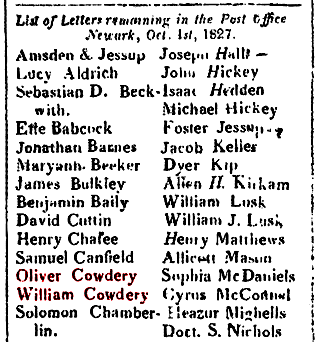
Lyons Advertiser, Nov. 27, 1827 (October letter list) (The earliest documented date for Oliver Cowdery in New York) Strange "Caractors" and Even Stranger Characters Was it only coincidence that on September 21, 1827, a mere ten months after his uncle Stephen has passed away, Joseph Smith allegedly discovered a manuscript of his own -- one which also just happened to be written in an indecipherable collection of hieroglyphics? And was it also mere coincidence when, in early 1828, Smith copied out a sample of those indecipherable symbols, for his financial backer, Martin Harris? The sample thus produced was the so-called "Anthon Transcript" which, thanks to David Whitmer's careful preservation, exists to this very day -- at least something was thus preserved, which is probably either a full or partial copy of that much mentioned Anthon Transcript. 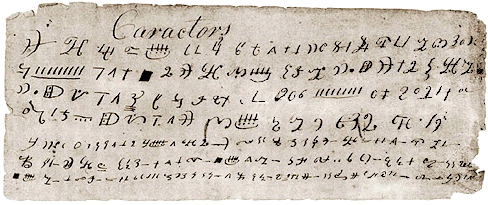
Joseph Smith's 1828 Transcript of the Nephite "Caractors" The person that Martin Harris hastened to visit, in an effort to identify the symbols in Joseph Smith's recently uncovered "Nephite Record" was none other than the same Dr. Samuel L. Mitchill whose picture is shown at the beginning of this web page -- the renowned savant who had initially been unable to decipher similarly odd symbols from the Detroit Manuscript. Was this 1828 pilgrimage of Martin Harris really his own idea,or was it just one element in a carefully crafted scheme to gain publicity and believers for Smith's forthcoming literary wonder, the Book of Mormon? An answer to this question seems to be provided in the report (Utah Evangel, 2001-2) of a remarkable study undertaken by Richard B. Stout, in which that researcher compared the symbols on the Anthon Transcript with both Irish ogham ciphers (found in the 14th century Book of Ballymore) and with certain symbols used early in the development of modern shorthand. According to Mr. Stout, he found a significant degree of correlation between Joseph Smith's "caractors" and both of these old means of communication. Deformed Egyptian? Even given Stout's interesting discovery, students of Mormon history should not presume that Joseph Smith simply recycled the same transcript Col. Edwards sent to Dr. Mitchill in 1823. Surely, if he had sent Martin Harris to Dr. Mitchill with the identical transcript that the learned professor had inspected only a few years earlier, Mitchill would have recalled his earlier attempt to decipher unknown writings symbols and would have branded Smith's transcript a patent copy. Therefore, it should be apparent that the symbols Smith gave to Harris early in 1828 could not have been exactly the same as those his Uncle's business partner sent Mitchill in 1823. However, accepting for a moment that Joseph Smith did manage to obtain a few pages from the old Detroit Manuscript, presumably nothing would have prevented him from playing his own private joke on Mitchill, by sending him, more than four years later, some of those Detroit markings, in slightly altered form, intermixed among other various kinds of "hieroglyphics," reproduced from actual Egyptian inscriptions, alchemists' symbols, proof-readers' marks, Masonic cyphers, or descriptions of Mayan "glyphs" and forgotten alphabets, provided in the popular press by reporters like Prof. Constantine S. Rafinsque, as early as 1827. 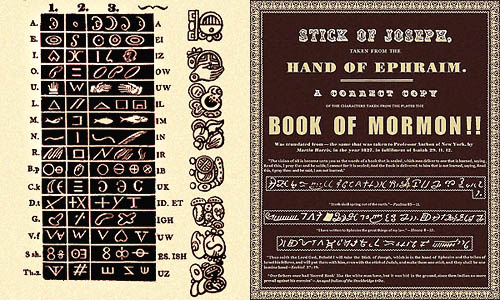
C. S. Rafinesque's ancient "glyphs" (left) and Joseph Smith's ancient "caractors" (right) And what better way to describe such a heterogeneous mixture than to style them Reformed Egyptian? Numerous facsimiles of Egyptian writing had been printed and widely circulated well before 1828. Smith and his associates could easily have obtained samples of these, even in western New York. By mixing some bits and pieces of Egyptian script in with the symbols from the 1823 Detroit Manuscript (which Mitchill had already demonstrated he could not translate properly), and then adding a few scribbles of his own, Mr. Smith could have created a veritable "sealed book" of deformed characters -- some partly resembling known Egyptian script and some having nothing to do with that language at all. 4 No matter what advances in decyphering real ancient Egyptian inscriptions might "come to pass" in future years, Joseph Smith's specimen of Nephite writing would forever remain unintelligible to any translator who did not have access the huge old spectacles originally provided with the "golden bible." Mormon polemicists have for many decades pointed out resemblances between markings from the Anthon Transcript and known symbols from actual Egyptian hieroglyphs and cursive scripts. One such attempt at making a correlation between these markings was RLDS President Israel A. Smith's three-part article, "The Language of the Book of Mormon," published in the LDS Saints' Herald between February and October 1942. In his article President Smith reproduces examples of Egyptian demotic symbols, juxtaposed with markings taken from the Anthon Transcript. Joseph Smith's grandson makes a good case for some of his grandfather's "caractors" having been derived from Egyptian demotic, as they may well have been! Other Mormon writers have occasionally cited resemblances between the "glyphs" reported by Prof. Rafinesque in 1827 and published by him, in tabulated form, only a few months after the Book of Mormon was printed. Although Prof. Rafinesque's identification of Mayan glyphs as New World developments of Lybian alphabets was long ago shown to be false, he did understand that the Mayan numerical system consisted of bars and dots. Since some of the markings on Joseph Smith's transcript also consist of lines and dots, they may owe something of their genesis to the good professor's "translation." 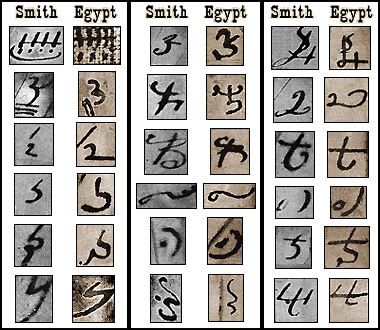
1942 comparison of Joseph Smith symbols & Egyptian demotic (From Israel A. Smith's "Book of Mormon Characters") Epilogue Given all of the above, what is the student of Mormon history to make of these strange reports and even stranger correlations? The parallels between the circumstances reported for the finding and identifying of the Detroit Manuscript and those surrounding the alleged discovery and translation of Joseph Smith's ancient record, are highly suggestive as to the true inspiration behind the origin of the Book of Mormon. Although the full story behind the Gold Bible business of 1827 and the publication of the Book of Mormon in 1830 may never be completely unraveled, every scrap of evidence and insight that can today be brought to light helps reveal the hidden genesis of Smith's Nephite Record -- and consequently, of Mormonism itself. It comes as no surprise that a religion replete with secretive ceremonies would also have secret beginnings. What is less understandable, is why so few people care to uncover the hidden schemes and happenings of generations, even when those forgotten events have given rise to vast modern organizations and belief systems. Add to the Gold Bible business the mysterious events surrounding the 1826 disappearance of William Morgan, (yet another manuscript scam never fully explained) and the way is paved for today's readers and researchers to fathom the covered over dealings between Smith and Cowdery in more than one shady book publication scheme -- the hitherto untold account of mutual cooperation and betrayal which perhaps began as early as 1822, and which directly impacted upon the origins of the Mormon Church. As a man of wisdom and truth said, ages ago, "Nothing is hidden unless it is to be disclosed, and nothing put under cover unless it is to come into the open. If you have ears to hear, then hear." 5 (Revised, January 2005, by William Moore --with appropriate bows to historians Dale Broadhurst and R. B. Stout) NOTES: 1. The reader is urged to distinguish between "hieroglyphics" in a general sense, and Egyptian hieroglyphics, which although a form of hieroglyphic writing, is not the form intended here. 2. When he reached western New York, Oliver Cowdery very likely became acquainted with her newspaper editor/publisher cousin, Benjamin Franklin Cowdery. At the end of 1822, B. Franklin Cowdery moved his family to Lockport, New York and there engaged in several months of job printing, using the press of Orsamus Turner when it was free for Cowdery's part-time work. At that time B. Franklin Cowdery was also acting as a sales agent for one or more publications issued from the press of James D. Bemis in Canadaigua. Among these emphemeral printed works was Bemis' Farmer's Diary, or Ontario Almanac for 1823, which, among other articles, carried an interesting account of money-digging. Whether or not Oliver served an apprenticeship under his printer cousin, in western New York, the strong probability remains that Oliver was associated with B. Franklin Cowdery when the printer set up shop in that region. This would have been the logical time for editors John St. John (then in Buffalo) and Orsamus Turner (then nearby at Lockport) to have first encountered Oliver Cowdery, whom both St. John and Turner describe as a young pedestrian peddler and dabbler in printing. Mr. Turner continues his account of Oliver's younger days, to the point of alleging that Oliver also frequented the Palmyra area and became involved with the Joseph Smith, Sr. family, at a time far earlier than most other accounts reveal. 3. In 1826 Joseph Smith, Jr. was brought under a court's examination for certain acts of mischief, and an eye-witness to that event later recalled that young Joseph possessed a singular stone, which he said he had obtained "on the South side of Lake Erie, not far from the New York and Pennsylvania line." According to this account, Joseph "left his father's house, and with his youthful zeal traveled west in search of this luminous stone.... After traveling some one hundred and fifty miles," following "some labor and exertion he found the stone... placed it in his hat, and discovered that... he possessed one of the attributes of Deity, an All-Seeing-Eye." (See William D. Purple's "Joseph Smith, the Originator of Mormonism," in the Norwich, N. Y. Chenango Union of May 3, 1877). 4. It should be pointed out that prior to the publication of Jean Francois Champollion's (1790-1832) work Precis du Systeme Hieroglyphique des anciens Egyptians, in 1824, no one could read Egyptian hieroglyphics at all. During his lifetime, even Champollion's work was a piecemeal progression, which did not immediately open the discernment of Egyptian writings systems to even the most diligent of his students. Although some subsequent progress in translating the ancient texts, including drawings, was summarized in Scotland's Edinburgh Review, of December, 1826 (85-147) and March, 1827 (528-539), this type of reporting remained an obscure subject in America until it was noticed towards the end of 1827 in the widely circulated Niles' Register, of Dec. 1, 1827, and thereafter in various American publications. 5. New English Bible, Mark IV:22-23. |
Editor's note: Mr. Moore's initial draft was responded to by Richard B. Stout
and that response remains on-line at the Spalding Research Project
To view Mr. Moore's initial draft, please consult the files at archive.org
Go to top of this page
Spalding Saga: intro | 01 | 02a | 03 | 04 | 05 | 06 | 07 | 08 | 09 | 10 | 11 | 12
Spalding Studies "Research" | Spalding Research Project | Special Collections
"Home" | Bookshelf | Mormon Classics | Newspapers | History Vault
Last Revised: Mar. 1, 2005